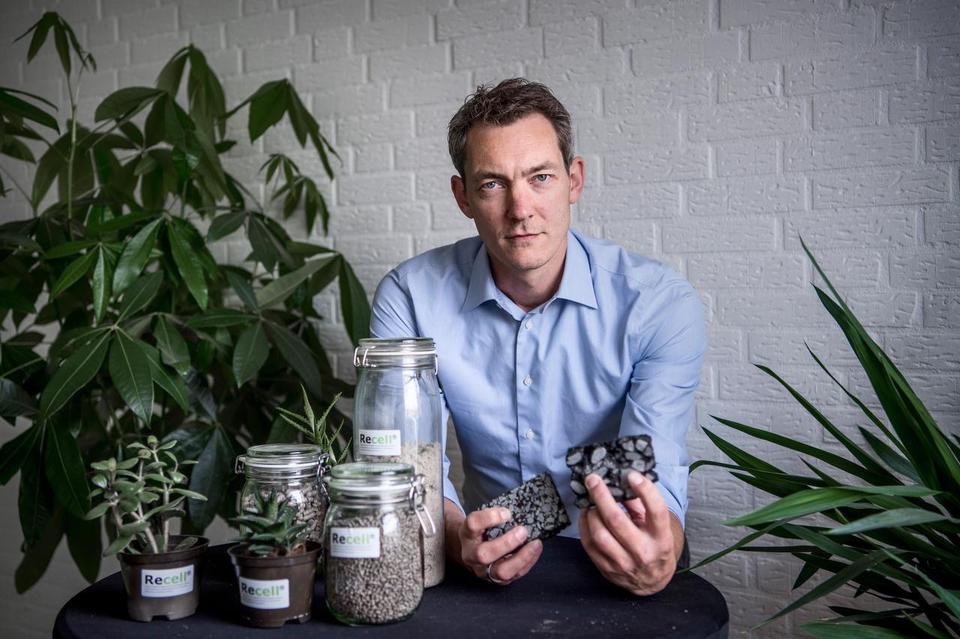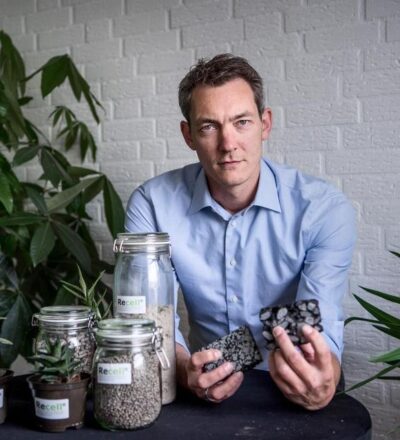For Recell’s Erik Pijlman there’s no doubt: cellulose extracted from waste streams is a valuable sustainable resource for the chemical industry. Thanks to ISPT he got in touch with chemical company Nouryon, and now, in the Cell-U-Value project, the route from cellulose to ‘green’ acetic acid is being developed jointly with the University of Groningen. It is a fine example of how ISPT offers start-ups and SMEs access to the broad network in sustainable process technology. This provides more resonance to good ideas and gives innovation more chance.

Cellulose is bio-based, reusable, non-toxic, and completely biodegradable
Erik Pijlman is a man with a mission. A mission to use cellulose from waste streams, so-called tertiary cellulose, as a valuable resource for the circular economy. “Cellulose is bio-based, reusable, non-toxic, and completely biodegradable,” the passionate entrepreneur makes his case. “Besides, the cellulose fiber has technical relevance and it can be used in a wide range of applications.” With colleagues from the Groningen-based environmental consultancy firm KNN, Pijlman wrote many reports about cellulose, and he discovered a gap in the market. “We saw many opportunities that were lost due to a missing link in the value chain. That’s why in 2015 we decided to start working on it ourselves and started the company KNN Cellulose”.
An important source of tertiary cellulose are the remains of used toilet paper that are found in sewage. These can be recovered with the Cellvation technology that KNN Cellulose now exploits in a subsidiary company together with Cirtec BV. The technology can also be used to produce circular cellulose from wet industrial waste streams. Applications for the recovered cellulose are being developed under the brand name Recell. “Think for instance of composites, and materials for building and insulation”, says Pijlman. He points out that a major effort goes into connecting sectors that are unknown to each other as they are not in the same value chain. “On the one hand water authorities, recycling industries and waste processors, and on the other hand, for example, the construction industry and the chemical industry. We see many opportunities to play a developing role there”.
More about the Cell-U-Value project.
Sustainable value chains in chemistry
Together with ISPT, Pijlman is now building a sustainable value chain for the chemical industry based on recovered cellulose. “Here, tertiary cellulose provides a sustainable alternative to fossil raw materials such as oil and natural gas,” says Pijlman, “but also to bio-based sources such as corn and sugar cane. It does not require farmland, so there is no displacement of acreage for food production”. He had been planning to bring this to the attention of the chemical industry for some time, but until now it didn’t come to that. “As a small business, you have to decide where to use your limited capacity – the ambition is always greater than what you can tackle. The chemical industry is also not the easiest sector to tap into. It’s difficult to get in at the right level and pitch your idea to the right people”.
Pijlmans’ prospects improved considerably when a support program for entrepreneurs led to contact with ISPT director Tjeerd Jongsma, who saw potential in the plans and brought these to the attention of the ISPT network. “Erik explained to me the amount and physical state of cellulose in waste water. Due to the very open structure and the high effective surface of this cellulose fibers, it is very well suitable as a resource for chemical modified cellulose. The only bottleneck I saw was recovery from the waste streams and that was the pert Erik already solved!”
Hence, the response of the ISPT network was quite positive and this ultimately led to close cooperation with chemical company Nouryon in the Cell-U-Value initiative, with the University of Groningen as a knowledge partner. The joint development focuses on acetic acid, an important ‘platform chemical’ that serves as a starting point for all kinds of chemical synthesis routes.
The idea is to crack the cellulose into sugar and turn it into acetic acid via fermentation. “It is important that the process can absorb variations in the quality of tertiary cellulose,” says Pijlman. “And we need to make sure that the whole route is sustainable.” He expects a pilot plant to be operational early next year, that will clarify what development is still needed. “But apart from developing technology, this is also about building chains: gathering strategic partners, establishing mutual commitment. That really is very important, also more widely in the circular economy”.
Gatekeeper
Pijlman emphasizes the great value of ISPT in building bridges towards the various partners in the chain. “That has been of great value to us – and actually still is.” To which Jongsma adds: “To our large network of companies and institutions we act as a kind of gatekeeper; they know that the ideas we pass on are most often quite meaningful. Then, of course, there is more interest than when you, as an SME, try to sell out your idea yourself – there is a lot of chaff between the wheat. In addition, we have a great deal of experience in creating and implementing collaborative projects, with good agreements on intellectual property”.
Pijlman: “To us, it is important that ISPT is able to achieve clout. I don’t think we could have achieved this on our own; it would have taken us ten years or more. To visit all potential parties and get them interested, for us that is simply not feasible. ISPT knows very well how to organize such a process and make it run smoothly. The cooperation is very pleasant and good: it feels a bit like an extension of our own operational organization”.
Acknowledgement
This project is co-funded with subsidy from the Topsector Energy by the Ministry of Economic Affairs and Climate Policy.
